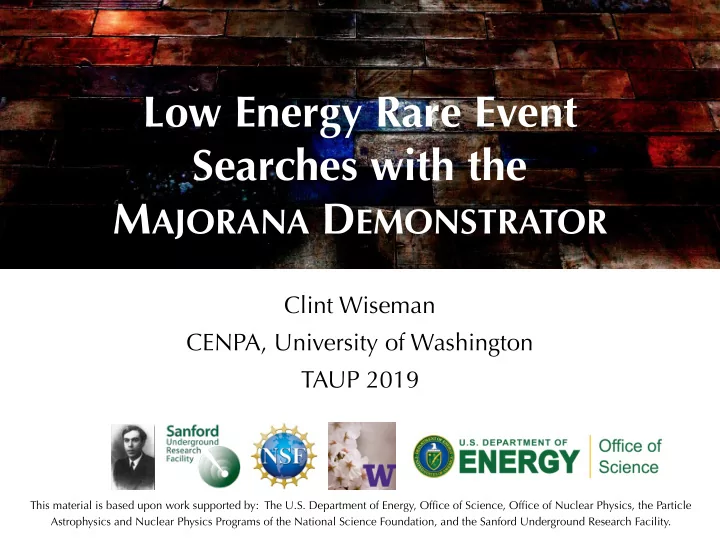

Low Energy Rare Event Searches with the M AJORANA D EMONSTRATOR Clint Wiseman CENPA, University of Washington TAUP 2019 This material is based upon work supported by: The U.S. Department of Energy, Office of Science, Office of Nuclear Physics, the Particle Astrophysics and Nuclear Physics Programs of the National Science Foundation, and the Sanford Underground Research Facility.
The M AJORANA D EMONSTRATOR Searching for neutrinoless double beta decay in 76 Ge and additional physics beyond the Standard Model • Source == Detector: 29.7 kg 88% enriched 76 Ge crystals • “PPC HPGe”: P-type point contact high-purity germanium • Excellent energy resolution: 2.5 keV FWHM @ 2039 keV • Low Backgrounds: 2 modules, compact graded shield, active muon veto, and ultra-clean materials • Recent Publications: PRL 120 132502 (2018): 9.95 kg-yr exposure PRC 100 025501 (2019): 26 kg-yr (unblinded) Operating at the Sanford Underground Research Facility Muon Veto Poly Shield Panels Radon Enclosure Lead Bricks Inner Cu Vacuum Shield and Cryogenics Outer Cu Shield Cryostats N. Abgrall et al. Adv. High Energy Phys, 365432 (2014) 2 Clint Wiseman, TAUP2019
The M AJORANA Low-Energy Program The D EMONSTRATOR has excellent energy resolution and extremely low backgrounds. Many rare event searches are possible: bosonic dark matter, solar axions, etc! Detectors are routinely operated at ~1 keV thresholds (using 5 keV threshold in this talk) Background above tritium region (18 keV) is a factor ~4 lower after shield completion DS1–6A (open) Enriched: 11.17 kg-y PRELIMINARY Natural: 3.69 kg-y Background 20–40 keV: ~0.01 cts/(kg-d)/keV DS-0 (commissioning) Enriched: 478 kg-d, Natural: 195 kg-d Background 20–40 keV: ~0.04 cts / (kg-d keV) Observations: • enr Ge shows much lower tritium (limited surface exposure) • 46 keV feature from 210 Pb (not previously visible) 3 Clint Wiseman, TAUP2019
Lightly Ionizing Particles (PRL 2018) Fractionally charged particles (f = e / a) could transit the array and light up a whole string of detectors Event Signature: a whole-string, non-muon event With 1 keV trigger thresholds + multiplicity cuts, we reached limits of e/1000 Published: PRL 120, 211804 (2018) Efficiency vs. f, Limit on LIP Flux m==4 events 4 Clint Wiseman, TAUP2019
Bosonic Dark Matter (PRL 2017) First results from M AJORANA used 478 kg-d of commissioning data (PRL 118, 161801 (2017)) Energy resolution: 0.4 keV FWHM at 10.4 keV Rare event searches: Bosonic dark matter, solar axions, electron decay (e - → 3 ν ) Pauli exclusion principle violation Ongoing efforts : Data denoising, pulse shape analysis, Efficiency (acceptance) of analysis cuts The current DS1—6A analysis is almost a factor 10 more enriched exposure (4080 kg-d, enr Ge) and a factor 6.9 more natural exposure (1347 / 195). Unblinding will give ~20 kg-y more. 5 Clint Wiseman, TAUP2019
Slow Pulses: Energy-Degraded n + Events Energy-degraded events from near the n+ surface are a challenging background for low-energy rare event searches with PPC HPGe detectors (CoGeNT, M AJORANA , CDEX, TEXONO, MALBEK, …) Charges slowly diffuse through the Ge/Li layer, and some make it to the bulk region after a delay, producing pulses with a measurably slower rise time (Degradation at the passivated surface is also possible) Exterior Bulk Surface Region Active Region No E-Field High E-Field Diffusion Only Fast-moving 6 Clint Wiseman, TAUP2019
<latexit sha1_base64="So8a4pfaAEycmuoBxpb2IjRAUg=">AC3icbVLPa9swGJW9H+2yX+l23EUsDFJKgx0G7aGDbjtsxw6WtlB5QVZkR1SyXelzaRA67zZ23Z+14/6SXafYLiTpPjB+fN975OenVZSGIiP0F47/6Dh1vbj3qPnzx9ry/8+LUlLVmfMJKWerzlBouRcEnIEDy80pzqlLJz9Lj8v52TXRpTFV1hUPFE0L0QmGAXfmvZ/E0VhrpW9+eSGsIvfYZJpyux7Z8cEaO0IvmXwm8phko8H7Yc2Ceqdrah4b1OSIzIFf027vQeNJLdFR+dMbfqE3sPc6XBjt36gtbrdsM+Xl/bDlt3L328IdpfxCNoqbwXRB3YIC6Opn2/5JZyWrFC2CSGnMRxUklmoQTHLXI7XhFWXNOcXHhZUcZPYJnqH3/jODGel9k8BuOmuKixVxixU6pnL65vN2bL531k1XxjBzNp6m6qN40B2mFhRVDXwgrWnyWqJocTLj41nQnMGcuEBZVr4C2E2pz5E8L9EzycVb+ZyF5yOR3E0ir+8HRwfdZlto1foNRqiGB2gY/QZnaAJYsFBkARZkIc0/B7+CH+21DoNC/RWoW/gFDunc</latexit> <latexit sha1_base64="So8a4pfaAEycmuoBxpb2IjRAUg=">AC3icbVLPa9swGJW9H+2yX+l23EUsDFJKgx0G7aGDbjtsxw6WtlB5QVZkR1SyXelzaRA67zZ23Z+14/6SXafYLiTpPjB+fN975OenVZSGIiP0F47/6Dh1vbj3qPnzx9ry/8+LUlLVmfMJKWerzlBouRcEnIEDy80pzqlLJz9Lj8v52TXRpTFV1hUPFE0L0QmGAXfmvZ/E0VhrpW9+eSGsIvfYZJpyux7Z8cEaO0IvmXwm8phko8H7Yc2Ceqdrah4b1OSIzIFf027vQeNJLdFR+dMbfqE3sPc6XBjt36gtbrdsM+Xl/bDlt3L328IdpfxCNoqbwXRB3YIC6Opn2/5JZyWrFC2CSGnMRxUklmoQTHLXI7XhFWXNOcXHhZUcZPYJnqH3/jODGel9k8BuOmuKixVxixU6pnL65vN2bL531k1XxjBzNp6m6qN40B2mFhRVDXwgrWnyWqJocTLj41nQnMGcuEBZVr4C2E2pz5E8L9EzycVb+ZyF5yOR3E0ir+8HRwfdZlto1foNRqiGB2gY/QZnaAJYsFBkARZkIc0/B7+CH+21DoNC/RWoW/gFDunc</latexit> <latexit sha1_base64="So8a4pfaAEycmuoBxpb2IjRAUg=">AC3icbVLPa9swGJW9H+2yX+l23EUsDFJKgx0G7aGDbjtsxw6WtlB5QVZkR1SyXelzaRA67zZ23Z+14/6SXafYLiTpPjB+fN975OenVZSGIiP0F47/6Dh1vbj3qPnzx9ry/8+LUlLVmfMJKWerzlBouRcEnIEDy80pzqlLJz9Lj8v52TXRpTFV1hUPFE0L0QmGAXfmvZ/E0VhrpW9+eSGsIvfYZJpyux7Z8cEaO0IvmXwm8phko8H7Yc2Ceqdrah4b1OSIzIFf027vQeNJLdFR+dMbfqE3sPc6XBjt36gtbrdsM+Xl/bDlt3L328IdpfxCNoqbwXRB3YIC6Opn2/5JZyWrFC2CSGnMRxUklmoQTHLXI7XhFWXNOcXHhZUcZPYJnqH3/jODGel9k8BuOmuKixVxixU6pnL65vN2bL531k1XxjBzNp6m6qN40B2mFhRVDXwgrWnyWqJocTLj41nQnMGcuEBZVr4C2E2pz5E8L9EzycVb+ZyF5yOR3E0ir+8HRwfdZlto1foNRqiGB2gY/QZnaAJYsFBkARZkIc0/B7+CH+21DoNC/RWoW/gFDunc</latexit> <latexit sha1_base64="So8a4pfaAEycmuoBxpb2IjRAUg=">AC3icbVLPa9swGJW9H+2yX+l23EUsDFJKgx0G7aGDbjtsxw6WtlB5QVZkR1SyXelzaRA67zZ23Z+14/6SXafYLiTpPjB+fN975OenVZSGIiP0F47/6Dh1vbj3qPnzx9ry/8+LUlLVmfMJKWerzlBouRcEnIEDy80pzqlLJz9Lj8v52TXRpTFV1hUPFE0L0QmGAXfmvZ/E0VhrpW9+eSGsIvfYZJpyux7Z8cEaO0IvmXwm8phko8H7Yc2Ceqdrah4b1OSIzIFf027vQeNJLdFR+dMbfqE3sPc6XBjt36gtbrdsM+Xl/bDlt3L328IdpfxCNoqbwXRB3YIC6Opn2/5JZyWrFC2CSGnMRxUklmoQTHLXI7XhFWXNOcXHhZUcZPYJnqH3/jODGel9k8BuOmuKixVxixU6pnL65vN2bL531k1XxjBzNp6m6qN40B2mFhRVDXwgrWnyWqJocTLj41nQnMGcuEBZVr4C2E2pz5E8L9EzycVb+ZyF5yOR3E0ir+8HRwfdZlto1foNRqiGB2gY/QZnaAJYsFBkARZkIc0/B7+CH+21DoNC/RWoW/gFDunc</latexit> Measuring Slow Pulses We need a slow pulse estimator that works at the Fast, 1.1 keV lowest S/N regions in the data We choose a heuristic function (exponentially modified Gaussian) and fit to each waveform. : center of rising edge, : exponential (RC) decay, μ τ : slope of rising edge (slowness!) σ Slow, 1.1 keV ✓ 1 + σ 2 ✓ t − µ ◆ ✓ σ ◆◆ xG( t ) = A τ − t − µ 2 τ exp erfc + B √ 2 τ 2 2 τ σ Waveform fit “slowness” ( ): σ Sensitive to fast, slow, and electronics noise. Distinction between fast and slow gets harder at lower energies … need a training set! Noise, 1.1 keV The fast pulse acceptance efficiency can be evaluated with high-multiplicity 228 Th calibration data to 1 keV Note: even for asymmetric signals, σ is still correlated with slowness of a pulse 7 Clint Wiseman, TAUP2019
<latexit sha1_base64="hzKqhwXj16uGJuoMOKCNod5B/c=">AB7HicbVBNS8NAEJ34WetX1aOXxSJ4KokI6q3oxWMF0xbaUDbTbt2swm7E6GE/gcvHlS8+oO8+W/ctjlo64OBx3szMwLUykMu63s7K6tr6xWdoqb+/s7u1XDg6bJsk04z5LZKLbITVcCsV9FCh5O9WcxqHkrXB0O/VbT1wbkagHKc8iOlAiUgwilZqdnHIkfYqVbfmzkCWiVeQKhRo9Cpf3X7CspgrZJIa0/HcFIOcahRM8km5mxmeUjaiA96xVNGYmyCfXTshp1bpkyjRthSmfp7IqexMeM4tJ0xaFZ9Kbif14nw+gqyIVKM+SKzRdFmSYkOnrpC80ZyjHlCmhb2VsCHVlKENqGxD8BZfXib+e265t1fVOs3RolOIYTOAMPLqEOd9AHxg8wjO8wpuTOC/Ou/Mxb1xipkj+APn8wcQXo78</latexit> <latexit sha1_base64="hzKqhwXj16uGJuoMOKCNod5B/c=">AB7HicbVBNS8NAEJ34WetX1aOXxSJ4KokI6q3oxWMF0xbaUDbTbt2swm7E6GE/gcvHlS8+oO8+W/ctjlo64OBx3szMwLUykMu63s7K6tr6xWdoqb+/s7u1XDg6bJsk04z5LZKLbITVcCsV9FCh5O9WcxqHkrXB0O/VbT1wbkagHKc8iOlAiUgwilZqdnHIkfYqVbfmzkCWiVeQKhRo9Cpf3X7CspgrZJIa0/HcFIOcahRM8km5mxmeUjaiA96xVNGYmyCfXTshp1bpkyjRthSmfp7IqexMeM4tJ0xaFZ9Kbif14nw+gqyIVKM+SKzRdFmSYkOnrpC80ZyjHlCmhb2VsCHVlKENqGxD8BZfXib+e265t1fVOs3RolOIYTOAMPLqEOd9AHxg8wjO8wpuTOC/Ou/Mxb1xipkj+APn8wcQXo78</latexit> <latexit sha1_base64="hzKqhwXj16uGJuoMOKCNod5B/c=">AB7HicbVBNS8NAEJ34WetX1aOXxSJ4KokI6q3oxWMF0xbaUDbTbt2swm7E6GE/gcvHlS8+oO8+W/ctjlo64OBx3szMwLUykMu63s7K6tr6xWdoqb+/s7u1XDg6bJsk04z5LZKLbITVcCsV9FCh5O9WcxqHkrXB0O/VbT1wbkagHKc8iOlAiUgwilZqdnHIkfYqVbfmzkCWiVeQKhRo9Cpf3X7CspgrZJIa0/HcFIOcahRM8km5mxmeUjaiA96xVNGYmyCfXTshp1bpkyjRthSmfp7IqexMeM4tJ0xaFZ9Kbif14nw+gqyIVKM+SKzRdFmSYkOnrpC80ZyjHlCmhb2VsCHVlKENqGxD8BZfXib+e265t1fVOs3RolOIYTOAMPLqEOd9AHxg8wjO8wpuTOC/Ou/Mxb1xipkj+APn8wcQXo78</latexit> <latexit sha1_base64="hzKqhwXj16uGJuoMOKCNod5B/c=">AB7HicbVBNS8NAEJ34WetX1aOXxSJ4KokI6q3oxWMF0xbaUDbTbt2swm7E6GE/gcvHlS8+oO8+W/ctjlo64OBx3szMwLUykMu63s7K6tr6xWdoqb+/s7u1XDg6bJsk04z5LZKLbITVcCsV9FCh5O9WcxqHkrXB0O/VbT1wbkagHKc8iOlAiUgwilZqdnHIkfYqVbfmzkCWiVeQKhRo9Cpf3X7CspgrZJIa0/HcFIOcahRM8km5mxmeUjaiA96xVNGYmyCfXTshp1bpkyjRthSmfp7IqexMeM4tJ0xaFZ9Kbif14nw+gqyIVKM+SKzRdFmSYkOnrpC80ZyjHlCmhb2VsCHVlKENqGxD8BZfXib+e265t1fVOs3RolOIYTOAMPLqEOd9AHxg8wjO8wpuTOC/Ou/Mxb1xipkj+APn8wcQXo78</latexit> A Low-E Compton Scatter Population θ γ 228 Th E 1 E 2 Many hit patterns possible with the ~50 detectors in the D EMONSTRATOR The 238 keV gamma from 212 Pb is not emitted in coincidence with others. Sum Energy (keV) Let’s look at m=2, sumE=238 keV events … Sum Energy (keV) 8 Clint Wiseman, TAUP2019
Recommend
More recommend